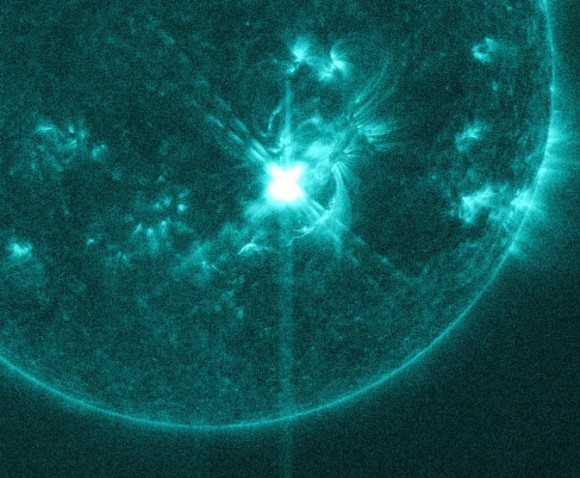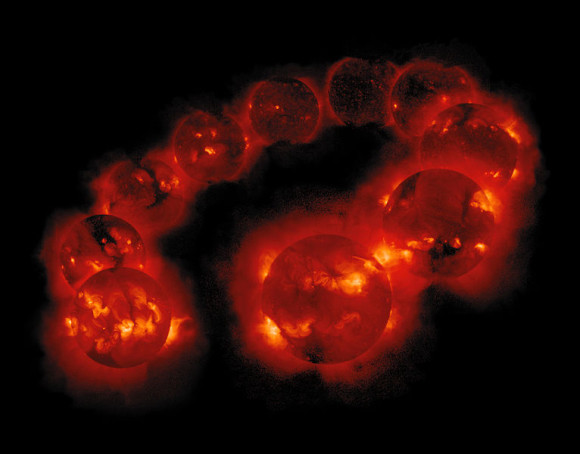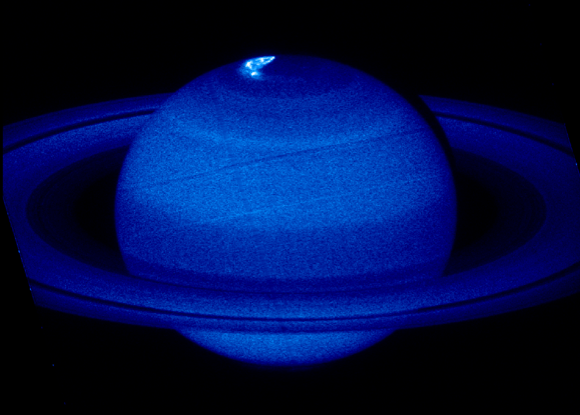Every 11 years, at the peak of the 11-year solar cycle, the sun’s magnetic polarity reverses itself. In other words, magnetic north and south on the sun flip. That flip is happening now, solar physicists say. In August, they were saying the sun’s reversal should occur “within the next 3-4 months.” This month, activity on the sun has been high; the sun has been crackling with solar flares including several X-flares. That solar activity caused Stanford University’s Wilcox Observatory to issue a press release on November 11 pointing out again that the reversal process is underway.
What will happen to humanity when the sun reverses its magnetic poles? Nothing that we know of. Effects on human bodies have never been observed, despite the fact that this reversal takes place regularly, on a timescale humans can monitor. Scientists will, however, see more sunspots, solar flares and coronal mass ejections or CMEs from the sun around the time of the sun’s magnetic flip. That solar activity, in turn, affects Earth’s magnetic field, which has the potential to affect earthly technologies, such as power distribution grids and GPS satellites. Read more about these effects: Are solar storms dangerous to us?
Plus, since the sun’s magnetic reversal comes at the peak of the sun’s cycle of activity, those at high latitudes on Earth are now seeing many beautiful auroras, or northern lights.
And it’s not just Earth, but also other planets, that are feeling the effects of the sun’s high activity, as its magnetic field is poised to reverse. Follow the links below to learn more.
Science of the sun’s magnetic reversals.
Effects of sun’s reversal on other planets.
Does the Earth’s magnetic field also reverse?


Science of the sun’s magnetic reversals. Scientists have been tracking the sun’s cycle of activity since at least the 19th century, but it wasn’t until 1908 that astronomer George Ellery Hale and his collaborators were able to explain the physical basis of the solar cycle, starting with their discovery that sunspots are strongly magnetized. In 1919, they went on to show that the magnetic polarity of sunspot pairs:
– Is always the same in a given solar hemisphere throughout a given sunspot cycle;
– Is opposite across the sun’s two hemispheres throughout a cycle;
– Reverses itself in both of the sun’s hemispheres from one sunspot cycle to the next.
Today, the sun’s activity is monitored at various solar observatories around the world, including Wilcox Solar Observatory, which has been tracking the sun’s polarity since the 1970s. Solar physicists at Wilcox have observed three solar reversals before this one, which will mark the midpoint of Solar Cycle 24.
They say that an interesting feature of this reversal is that, in 2013, the sun’s hemispheres are changing polarity at different rates. The sun’s northern hemisphere flipped this summer; the southern hemisphere should flip in the near future.
According to Todd Hoeksema at Wilcox Solar Observatory, during the reversal the sun’s polar magnetic fields weaken, go to zero and then emerge again with the opposite polarity. Hoeksema said in the November 11 press release:
It’s kind of like a tide coming in or going out. Each little wave brings a little more water in, and eventually you get to the full reversal.


Effects of sun’s reversal on other planets. We think of our sun as a star, a discrete body in space. But solar physicists think in terms of the sun’s heliosphere – the sphere of the sun’s influence – which extends beyond Pluto and past even where NASA’s Voyager probes are moving on the edge of interstellar space.
When the sun reverses polarity, the effects extend out through the entire heliosphere. Hoeksema said that, during a reversal in the sun’s polarity, Jupiter has storms, and Saturn has auroras.
Does the Earth’s magnetic field also reverse? Earth’s magnetic field is also known to flip. It has flipped many times over the last billion years.
But Earth’s magnetic field reversals happen much less frequently. The time between geomagnetic reversals can vary, and are imprecisely known, but the average time between reversals appears to be on the order of hundreds of thousands of years (usually). When a reversal in Earth’s magnetic field occurs, instead of happening over a few months as on the sun, the process can take between 1,000 and 10,000 years, scientists believe. There’s also some evidence that some geomagnetic reversals can happen more quickly.
Some evidence suggests that Earth’s magnetic field weakens in staggered steps, and that its strength has declined by a few percentage points since 1840. That is why you sometimes hear people say that Earth’s magnetic field is heading toward a reversal in polarity soon. It’s good to remember that, in Earth’s case, “soon” could mean within the next several thousand years.
Most scientists believe that, unlike on the sun, Earth’s magnetic field will not go to zero when it reverses.
Bottom line: The sun has been extremely active in November 2013, prompting at least one group of solar physicists – at Stanford’s Wilcox Solar Observatory – to issue a press release pointing out the reversal in the sun’s magnetic polarity is happening now and will soon be complete.











